What is Blog SEO?
Blog SEO is the process of using technical and on-page SEO techniques to increase your blog's visibility in organic search. When using blog SEO, you have two primary goals:
To make sure search engines can find and understand your blog posts so that they can deliver them to relevant searchers To make sure you're writing relevant blog content that aligns with your audience's needs and interestsThe techniques used to do this are not altogether different from those you'd use to optimize the content on other parts of your site. As such, if you're already an SEO practitioner, these strategies may be familiar to you.
The chief difference is that when you're working on a blog, you're explicitly using SEO to support an ongoing long-form content strategy. That means developing in-depth, informative, and relevant content that aligns with your audience's needs and search intent and using the SEO tactics you may already know to help that content succeed.
Why is Blogging Important for SEO?
With every post you create and optimize, you can:
Increase your visibility in organic search Establish your credibility as a trusted resource Build your site's authority over timeImagine you're starting a B2C technology company. You want to help consumers understand their tech, use it more effectively, and solve problems without having to pay an arm and a leg for expensive repair services.
If you want to be successful, you have to get your name out there, so customers know you and prove that you're trustworthy and knowledgeable in your field. Blogging can help you do that.
A well-maintained blog provides your site with a steady stream of brand new, original, quality content. Over time, as readers and search engines discover that content, you'll begin to be recognized as a reliable source of information, which will help you rank higher.
6 Ways To Optimize Blog Content for Search Engines
SEO is a long game. It can take time to see the results. So if you're just getting started, it's okay to chunk your tasks and tackle the more accessible items first while you figure out the more complex aspects of your new SEO strategy.
To make it a little easier for you, we've broken down our best blog SEO tips to improve your content and climb the rankings in search.
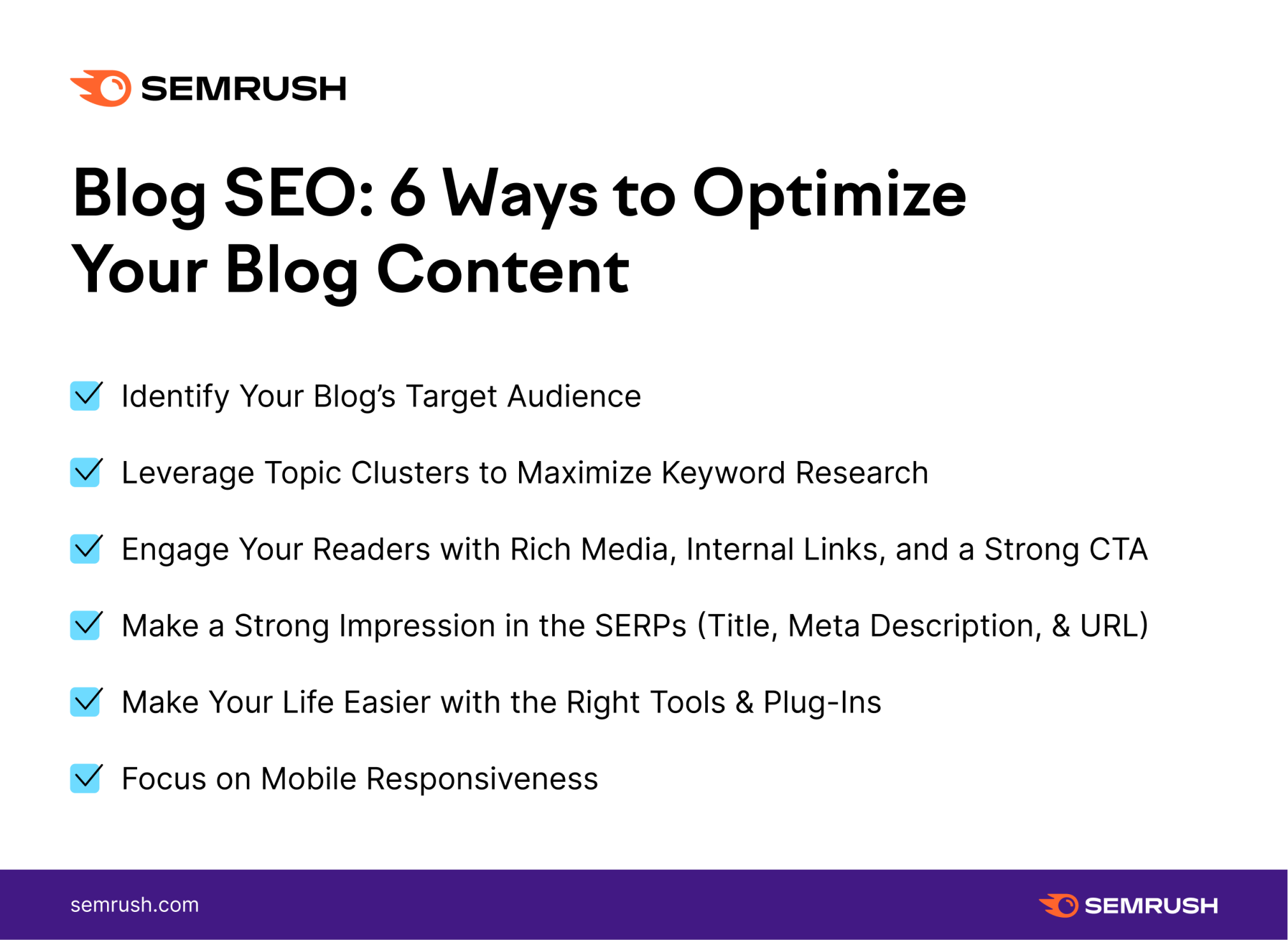
Identify Your Blog's Target Audience
Before you ever start writing, if you want your blog to be successful, you've got to know who is likely to be reading it. That's your target audience, the group of people who most are likely to:
Search for the terms you're targeting Need products or services provided by companies like yours Become your customers (hopefully)To define your target audience, take a look at your current customer demographics. Find out who's already engaging with your brand. You probably already have a lot of this information on hand. A few invaluable sources of information:
Information you've collected during lead generation and sales Insights from your sales team Your Google Analytics data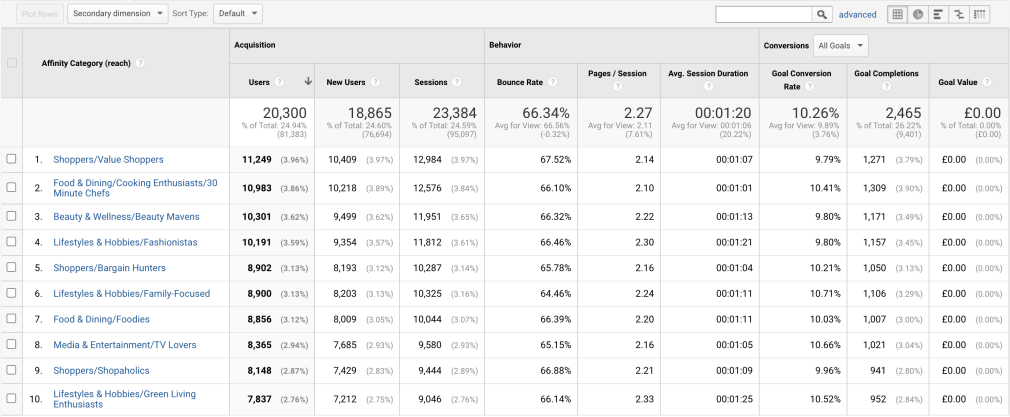
Next, investigate your social media presence. Odds are, you've built up a following already. But who are they? Luckily, Facebook and Instagram offer Audience Insights reports to help you understand your audience demographics. Here, you can learn:
Their age and gender breakdown Where they are The best time to post, based on your follower activityFinally, find out how your audience compares with the competition using the Traffic Analytics Audience Insights report. Enter your domain and your major competitors' domains to find out:
The relative size of each of your audience How much your audiences overlap Other websites your audience (or your competitor's) are likely to visit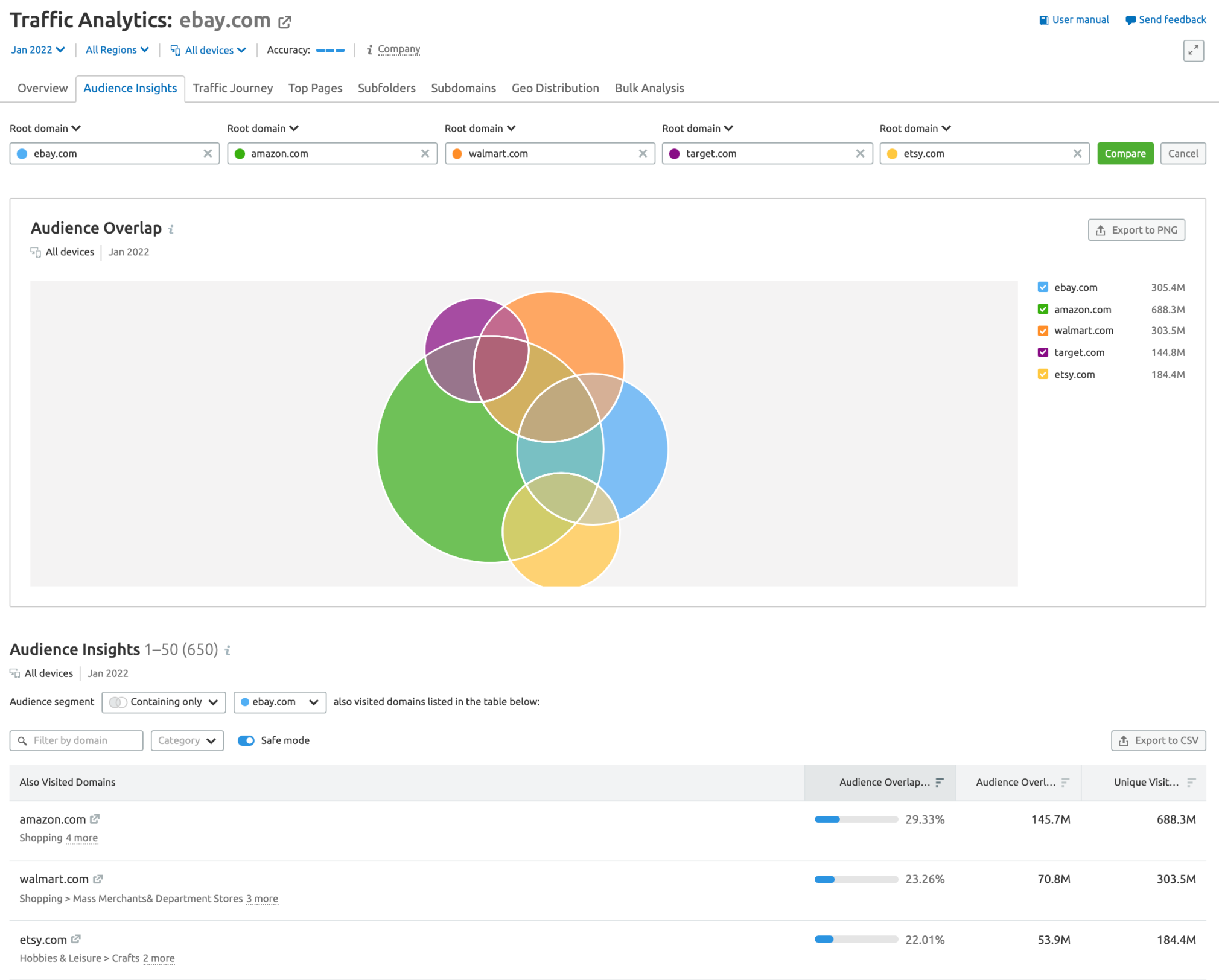
By putting all this information together, you'll have a more comprehensive picture of your target audience. Use what you learn to create content that speaks directly to their needs.
Leverage Topic Clusters to Maximize Keyword Research
Comprehensive keyword research is critical to a blog's success. If you want to maximize your keyword impact, try creating topic clusters.
A topic cluster is a group of blog posts that, put together, go in-depth on a broader subject.
They're usually organized around a central hub page that links to other content.
With topic clusters, you can target various related, less competitive keywords to try and rank for a broader and more difficult umbrella keyword. They can have numerous benefits for your SEO, including:
Improving your blog's visibility by making it easier for search engines to crawl Increasing your blog's authority in that topic over time Enabling you to rank for broader and more difficult keywords Allowing more successful posts to boost less successful ones through interlinkingThey also appeal to Google's latent semantic indexing (LSI) algorithm.
But how do you create a topic cluster?
First, select your pillar topic. Pick something relevant to your business that you have a great deal of expertise in. Pillar topics should be the primary keyword for your hub pages. Then several related sub-topics you want to cover to support it.
Not sure where to start? Plug a topic you're interested in writing about into the Keyword Magic Tool. Then, look at the search volume and Keyword Difficulty Score to identify the most efficient ones.
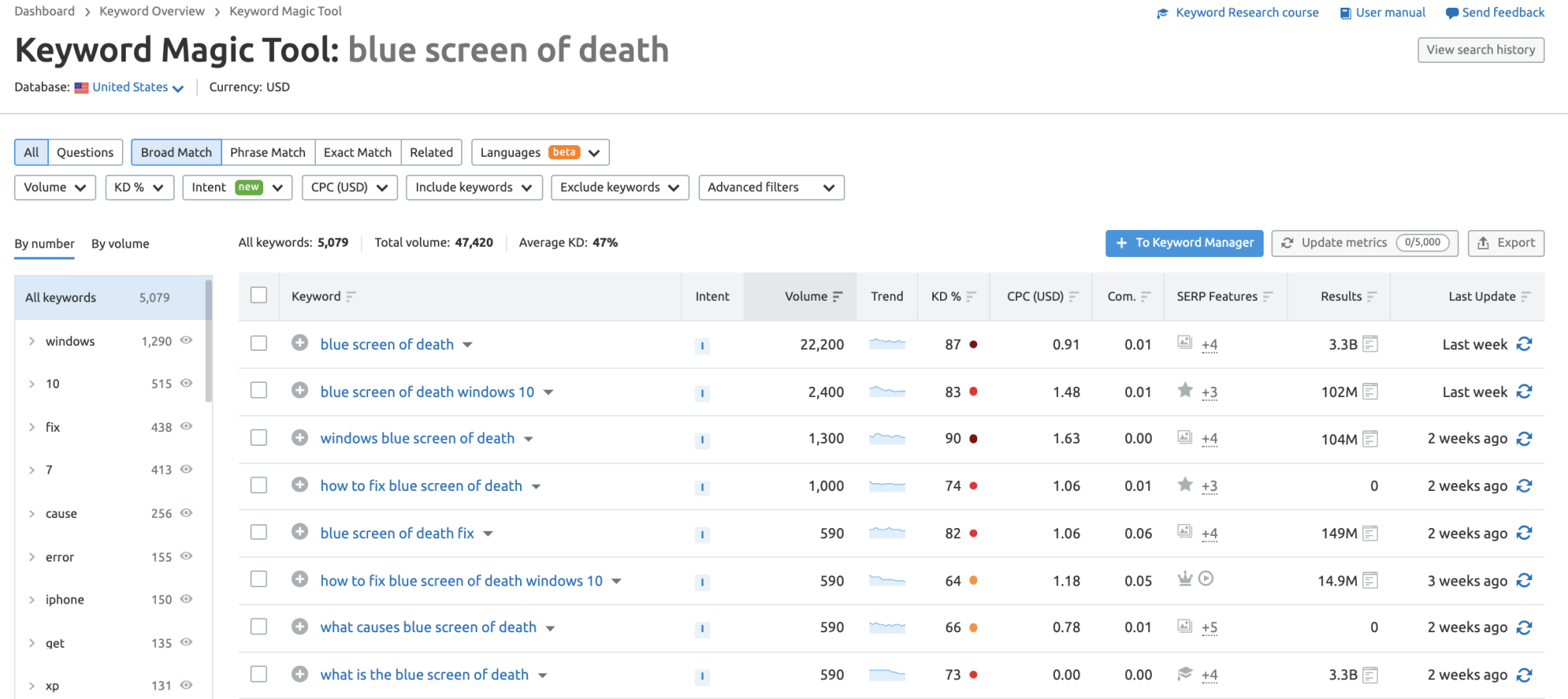
Use the broadest keyword for your topic cluster's hub page. Then, focus on more specific keywords for the individual pieces of content that hub pages link to.
Once you're ready, enter those keywords into the Topic Research Tool to generate ideas for articles.
The Topic Research Tool can generate tons of content ideas, identify trending topics, and sort them by volume, difficulty, or efficiency (high volume, low difficulty ideas).
Add your new topic ideas to your content calendar to build out your cluster. As you post new articles, make sure you add them to your hub page so readers (and search engines) can find them later.
Engage Your Readers with Rich Media, Internal Links, and a Strong CTA
Long-form written content isn't the only way to communicate with your audience. If you want your blog to stand out, engage your audience with rich media like photos, videos, audio, or custom infographics.
Rich media can also be a great way to springboard to other pieces of cluster content under the same pillar.
Not sure where to start? Google provides a handy tutorial on incorporating rich media into your content.
Video content is particularly worth the effort for a new blog post. Videos keep the user on a page for a certain amount of time, which can help your bounce rate low.
Video is also a popular form of media, as shown by platforms like TikTok and YouTube.
Even better, you can often repurpose blog content for videos, streamlining your content creation process.
But hooking your readers with rich content is only half the battle. If you want to keep them engaged on your site after they're finished reading, you'll need a solid internal linking strategy.
By including links to other pages in each post, you encourage readers to explore your website further, keeping them on your platform longer. This can also help search engines find other relevant authority pages you have to offer.
Here are a few tips for more effective internal links:
Don't use more than five words in your anchor text. Use your anchor text to provide context for the reader about what they should expect to find. Make sure your links not only support your article but are also valuable and relevant to the reader.Make a Strong Impression in the SERPs (Title, Meta Description, & URL)
It's easy to forget, but your blog post introduction probably isn't your reader's first impression of that content. Instead, if they're coming from organic search, their first impression probably comes from your page's appearance in the SERPs.

The truth is, you don't have complete control over how your page appears when it comes up in search results. But you can still improve it by optimizing your page title, meta description, and URL.
First, choose an engaging page title. Now, technically, you get two opportunities to title your article. The page title is the first of these. You can find it in your page's HTML head element between <title> tags. When you publish your article, it will appear at the top of the browser window and SERPs.
Here are a few pointers to help you write a more effective page title:
Keep it short. Search results will show the first 50-60 characters on mobile before truncating it. Keep it accurate. Your title should accurately reflect what the page is about. Use words like "how," "what," or "why," and include solid descriptors to convey the type of information the reader will find. Keep it unique. It may be tempting to recycle the same title tag across your site, but it's not helpful for your SEO or audience. Instead, write a new title tailored for each page.Next, turn your attention to the meta description. While meta descriptors might not directly affect your SEO, a solid meta description can have a significant impact on your click-through rate (CTR). In other words, this is your opportunity to convince your searchers to visit your page.
It's important to note here that the meta description you write might not be the one that appears in search results every time. Google often rewrites meta descriptions to align more closely with the user's search.
With that in mind, here are a few tips for impactful meta descriptions:
Mind your character count. You have room for about two sentences of up to 160 characters. Mind your first sentences. If Google rewrites your meta description, they often pull from the first sentences of the relevant section for that user's search. Mind the competition. Try searching for the terms you're targeting yourself, and look at how the pages currently ranking have written their snippets. Do they have anything in common? Use what you learn to improve your description.Finally, take a look at your URL. Put yourself in the position of your audience. If you didn't have any other context to go on, would you be able to figure out what your page means on the URL alone? If not, you might want to rethink it.
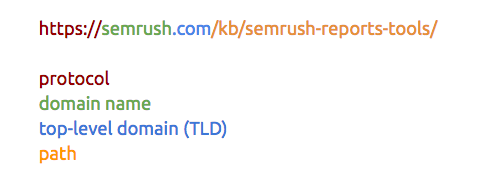
Your URL has four parts: the protocol, domain name, top-level domain, and path. Here, we'll be focusing on the URL path.
An effective URL path should:
Tell the reader what the page is about Show the reader where they are on your site (e.g., on the blog or in another subfolder) Include your focus keyword (if possible)Together, a compelling page title, meta description, and SEO-friendly URL can improve your appearance in search results and even help to increase your CTR.
Make Your Life Easier with the Right Tools & Plug-Ins
Many content management systems (CMS) offer plugins that can help streamline your blog SEO efforts.
For example, run a WordPress site. You could install Semrush's SEO Writing Assistant, which helps you improve and optimize your content in real-time, using suggestions based on the current highest-ranking pages.
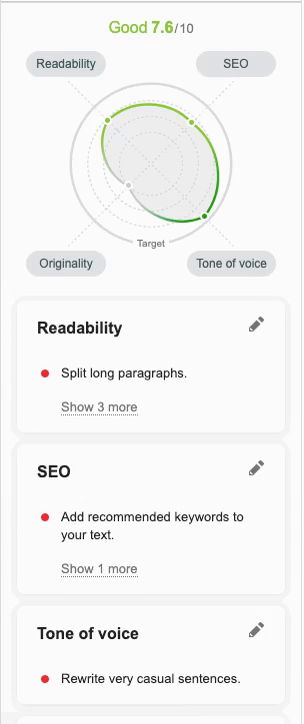
Another popular option for WordPress is Yoast SEO, which integrates with Semrush. You get a module on each page's edit post when you install it, showing you how your page performs in crucial SEO criteria. It analyzes everything from content length to inbound links, the meta title, focus keyword placement, and the size of the meta title.
Overall, if you choose the best ones for you, plugins can save you valuable time with on-page SEO. That said, too many plugins can slow your site down, negatively impacting your SEO. So be choosy, and only add tools and plugins that will genuinely benefit your workflow and your site as a whole.
Focus on Mobile Responsiveness
While you don't have to offer a mobile-friendly website, it's an essential factor if you want to rank. Ever since 2019, Google's used mobile-first indexing. This means that it prioritizes the mobile version of the content over the desktop version when indexing and ranking web pages.
The first step you can take to check if your site is mobile-friendly is to run it through Google's mobile-friendly test tool. This will flag some fundamental issues and how to fix them.
To optimize your site for mobile, consider using responsive design rather than separate URLs for mobile and desktop. This way, content is more accessible to share across devices, and backlinks to your blog won't be divided among two URLs, increasing the power of these inbound links.
Here are a few simple stylistic steps you can take to make for a more user-friendly mobile experience:
Avoid large chunks of text, which are harder to read on mobile devices Use headers to organize your text into smaller sections Avoid displaying content wider than the screen Space your clickable elements out so that they're easier to engage with on small screens Use reader-friendly text, avoiding fonts that are too small or difficult to readSimplify Blog SEO with Semrush
You don't have to know the ins and outs of Google's algorithm or become an HTML expert to optimize your blog. Instead, Semrush can help you do the heavy lifting. From domain overview tools to organic keyword research technology and site audit assistance, Semrush can help you get a handle on things as you optimize blog SEO. That way, you'll have more time to create compelling content your audience will love.
Innovative SEO services
SEO is a patience game; no secret there. We`ll work with you to develop a Search strategy focused on producing increased traffic rankings in as early as 3-months.
A proven Allinclusive. SEO services for measuring, executing, and optimizing for Search Engine success. We say what we do and do what we say.
Our company as Semrush Agency Partner has designed a search engine optimization service that is both ethical and result-driven. We use the latest tools, strategies, and trends to help you move up in the search engines for the right keywords to get noticed by the right audience.
Today, you can schedule a Discovery call with us about your company needs.
Source:





